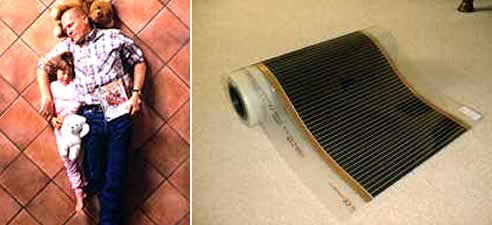NEWS ARTICLE ARCHIVESIntroduction to carbon film radiant heating from CBS Interest with regards to the impact on "Energy Efficiency" and the current issues surrounding health & safety of systems for general climate control within the average home and work area has created a remarkable increase in the demand for a low cost, space saving and healthy heating system. The product Safe-t-FLEX, designed and developed by Flexel International, has endured rewarding international success in the radiant heating industry. With over 2.5 million square metres of this product installed over twenty years in the UK and being issued the Queen's Award to Industry on two occasions, Flexel, trade marked Safe-t-FLEX has extensively displayed its energy saving ability and quality health and safety profile within the market place. Safe-t-FLEX Carbon Film: Floor Radiant Heating The primary design advantage of this heating system compared to current radiant heat devices is the fundamental usage of Black Body Radiant Heating Principals. There are six principal comfort components, which should be taken into consideration when applying comfort heat design: Air temperature; mean radiant temperature, humidity, air velocity, activity levels and thermal resistance of clothing. The most overlooked of all these principals is the mean radiant temperature (MRT) on general comfort conditions. The ability to directly heat objects and surfaces within a room will reduce the general physiological effects of heat transfer from the human body. An established MRT within a room strongly influences the feeling of comfort. When the general surface temperature of the outside walls, particularly those with large amounts of glass begins to deviate excessively from the ambient air temperature of the space, it is increasingly difficult for convective style heating systems to counteract the discomfort resulting from cold walls and the like. Carbon film heating elements installed above the ceiling distributed evenly over the ceiling areas with increased density towards high heat loss perimeter areas will create an MRT condition effectively. The low intensity availability of heat to a large area provides the ability to maintain this condition with ambient temperature variations. The generation of radiant energy from a surface is a function of the surface temperature and is described by the Stefan-Boltzman law which states "The emissive power of a black body is proportional to the fourth power of the absolute temperature" A surface or body which absorbs all of the incidental radiant energy without reflection or transmission is called "A Black Body". A perfect black body has a heat emissive factor of (100%) where as elements using grey body principals may have a reduced emissive factor around (70%). In simple terms if a body is brought above the temperature of surrounding surfaces - heat transfer will take place to the cooler surfaces. Bringing this body up to temperature is a function of the bodies' absorptive qualities and results in a time frame to reach optimum temperature. The faster we can obtain an MRT condition within a room the more efficient the operation of the system based on the simple understanding that the thermostat cycling period is directly proportional to the mean radiant temperature (MRT) maintenance rate. A good physical demonstration of this concept is simply by energising a carbon-film (black body) heating element to optimum element surface temperature in a corresponding lower room temperature. By switching the power supply off and measuring the time taken to bring the element back to its natural de-energised temperature is an excellent indication of the element's heat release abilities. When energised the element is releasing heat to the space at this observed and sensed rate. We all understand why solar hot water design uses high absorptive black body principals to increase the rate of absorption and heat transfer to the water medium. Let's just replace the water with a room space, the absorption cells with a carbon element and the sun with a small amount of electrical energy to power the heating elements. The ability of the elements to run at low temperatures is a result of their heat release design and general thermal efficiencies. |
 |
 |